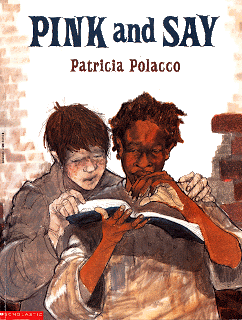
Every time that I have entered an elementary school library over the last few months and asked what picture book I should read, I have been referred to some book by Patricia Polacco. Pink and Say is one of my two favorites.
Pink and Say is the story of a Union Civil War soldier, rescued by the 1st black person that he had ever seen, Pinkus. Pinkus takes the soldier, Sheldon Curtis, to the home where his mother, Moe Moe Bay, is now living. Their friendship grows when they spend time healing from their wounds and learning about each other. Pinkus, a former slave, even offers to teach Sheldon to read.
This story gives explanation of where slave names came from and other important cultural explanations like "jumping the broom."
The use of words, complimented by the use of white in the drawings adds as much as the expert use of color. Pinkus calls slavery "the sickness" and he is called "polised mahogany" by Sheldon. I found both of these uses of figurative language to be touching.
This story was passed to Polacco in an oral tradition, from her great-grandfather to her grandmother. It ends with the statement 'When you read this, before you put this book down, say his name out loud and vow to remember him always.' This statement made me believe in the power of text and the beauty of Polacco's drawings, because I sure did what she told me to. Overall, this was one of the most touching stories that I have ever read, not only because of the content, but because of the words played against the drawings.
Polacco, Patricia. Pink and Say. Putnam & Grosset Group, 1994. ISBN 0-399-22671-0.







